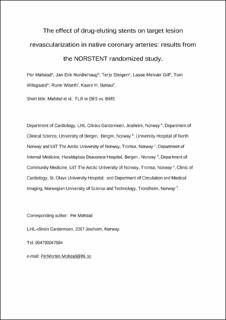| dc.description.abstract | Background: The NORSTENT trial randomized 9,013 patients to percutaneous coronary intervention (PCI) with a drug-eluting stent (DES) or bare-metal stent (BMS) with 5-year follow-up. No difference was found in the composite primary outcome of death from any cause and nonfatal spontaneous myocardial infarction after a median of 5 years of follow-up. Secondary outcomes included repeat revascularizations, which were reduced by DES. We report the occurrence of target lesion revascularization (TLR) in time and across demographic and clinical subgroups in patients with lesions in native coronary arteries (n = 8,782). Results: Clinically driven TLR was performed on 488 (5.6%) of the 8,782 patients during 5 years of follow-up. Male gender, older age, visible thrombus in the lesion, and larger stent diameter were associated with less TLR; multivessel disease and longer stents were associated with a higher risk of TLR. There was a substantial and highly significant reduction of the risk of any TLR after 5 years in the DES group (hazard ratio [HR] 0.44, 95% confidence interval [CI] 0.36–0.52], p < 0.001). The effect of DES on TLR was limited in time to the first 2 years in the study with no evidence of a later rebound effect. The reduction in TLR after DES insertion was consistent across subgroups defined by gender, age, diabetes status, renal function, and lesion and stent characteristics. The number needed to treat with DES (vs. BMS) to prevent 1 TLR ranged from 4 to 110 across clinically relevant subgroups. Conclusion: DES have a time-limited effect on the rate of TLR, but with a substantial and highly significant reduction in the first 2 years after the procedure. This effect was found to be consistent across all important clinical subgroups. | en_US |
